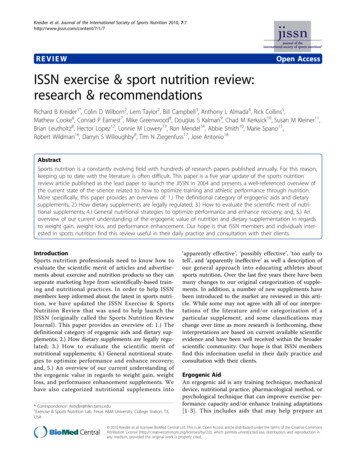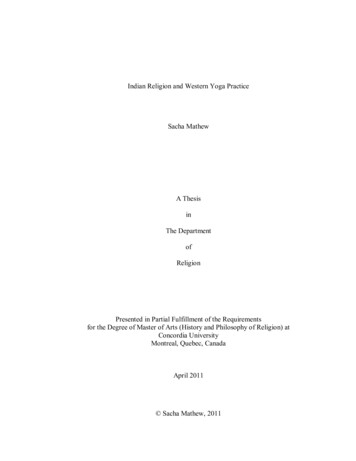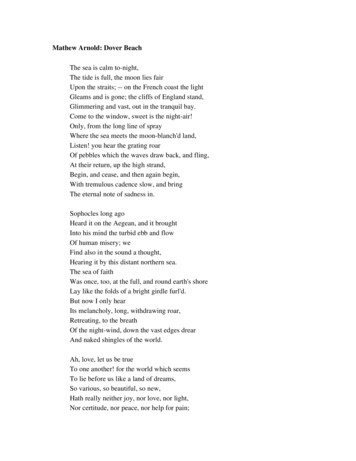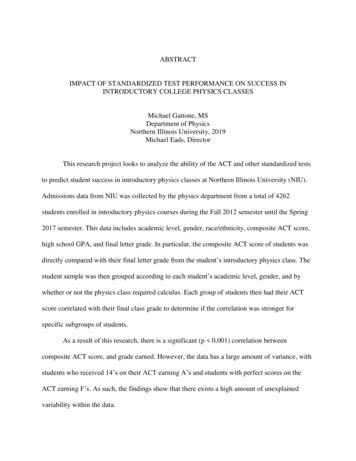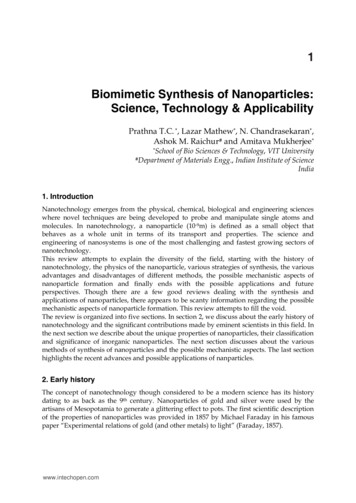
Transcription
Biomimetic Synthesis of Nanoparticles: Science, Technology & Applicability1X1Biomimetic Synthesis of Nanoparticles:Science, Technology & ApplicabilityPrathna T.C. *, Lazar Mathew*, N. Chandrasekaran*,Ashok M. Raichur# and Amitava Mukherjee**School#Departmentof Bio Sciences & Technology, VIT Universityof Materials Engg., Indian Institute of ScienceIndia1. IntroductionNanotechnology emerges from the physical, chemical, biological and engineering scienceswhere novel techniques are being developed to probe and manipulate single atoms andmolecules. In nanotechnology, a nanoparticle (10-9m) is defined as a small object thatbehaves as a whole unit in terms of its transport and properties. The science andengineering of nanosystems is one of the most challenging and fastest growing sectors ofnanotechnology.This review attempts to explain the diversity of the field, starting with the history ofnanotechnology, the physics of the nanoparticle, various strategies of synthesis, the variousadvantages and disadvantages of different methods, the possible mechanistic aspects ofnanoparticle formation and finally ends with the possible applications and futureperspectives. Though there are a few good reviews dealing with the synthesis andapplications of nanoparticles, there appears to be scanty information regarding the possiblemechanistic aspects of nanoparticle formation. This review attempts to fill the void.The review is organized into five sections. In section 2, we discuss about the early history ofnanotechnology and the significant contributions made by eminent scientists in this field. Inthe next section we describe about the unique properties of nanoparticles, their classificationand significance of inorganic nanoparticles. The next section discusses about the variousmethods of synthesis of nanoparticles and the possible mechanistic aspects. The last sectionhighlights the recent advances and possible applications of nanparticles.2. Early historyThe concept of nanotechnology though considered to be a modern science has its historydating to as back as the 9th century. Nanoparticles of gold and silver were used by theartisans of Mesopotamia to generate a glittering effect to pots. The first scientific descriptionof the properties of nanoparticles was provided in 1857 by Michael Faraday in his famouspaper “Experimental relations of gold (and other metals) to light” (Faraday, 1857).www.intechopen.com
2Biomimetics, Learning from NatureIn 1959, Richard Feynman gave a talk describing molecular machines built with atomicprecision. This was considered the first talk on nanotechnology. This was entitled “There’splenty of space at the bottom”.The 1950’s and the 1960’s saw the world turning its focus towards the use of nanoparticlesin the field of drug delivery. One of the pioneers in this field was Professor Peter PaulSpeiser. His research group at first investigated polyacrylic beads for oral administration,then focused on microcapsules and in the late 1960s developed the first nanoparticles fordrug delivery purposes and for vaccines. This was followed by much advancement indeveloping systems for drug delivery like (for e.g.) the development of systems usingnanoparticles for the transport of drugs across the blood brain barrier. In Japan, Sugibayashiet al., (1977) bound 5-fluorouracil to the albumin nanoparticles, and found denaturationtemperature dependent differences in drug release as well as in the body distribution inmice after intravenous tail vein injection. An increase in life span was observed afterintraperitoneal injection of the nanoparticles into Ehrlich Ascites Carcinoma-bearing mice(Kreuter, 2007).The nano- revolution conceptually started in the early 1980’s with the first paper onnanotechnology being published in 1981 by K. Eric Drexler of Space Systems Laboratory,Massachuetts Institute of Technology. This was entitled “An approach to the developmentof general capabilities for molecular manipulation”.With gradual advancements such as the invention of techniques like TEM, AFM, DLS etc.,nanotechnology today has reached a stage where it is considered as the future to alltechnologies.3. Unique properties of nanoparticlesA number of physical phenomena become more pronounced as the size of the systemdecreases. Certain phenomena may not come into play as the system moves from macro tomicro level but may be significant at the nano scale. One example is the increase in surfacearea to volume ratio which alters the mechanical, thermal and catalytic properties of thematerial. The increase in surface area to volume ratio leads to increasing dominance of thebehaviour of atoms on the surface of the particle over that of those in the interior of theparticle, thus altering the properties. The electronic and optical properties and the chemicalreactivity of small clusters are completely different from the better known property of eachcomponent in the bulk or at extended surfaces. Some of the size dependant properties ofnanoparticles are quantum confinement in semiconductors, Surface Plasmon Resonance insome metallic nanoparticles and paramagnetism in magnetic nanoparticles.Surface plasmon resonance refers to the collective oscillations of the conduction electrons inresonance with the light field. The surface plasmon mode arises from the electronconfinement in the nanoparticle. The surface plasmon resonance frequency depends notonly on the metal, but also on the shape and size of the nanoparticle and the dielectricproperties of the surrounding medium (Jain et al., 2007). For example, noble metals,especially gold and silver nanoparticles exhibit unique and tunable optical properties onaccount of their Surface Plasmon Resonance.Superparamagnetism is a form of magnetism that is a special characteristic of smallferromagnetic or ferromagnetic nanoparticles. In such superparamagnetic nanoparticles,magnetization can randomly change direction under the influence of temperature.www.intechopen.com
Biomimetic Synthesis of Nanoparticles: Science, Technology & Applicability3Superparamagnetism occurs when a material is composed of very small particles with a sizerange of 1- 10nm. In the presence of an external magnetic field, the material behaves in amanner similar to paramagnetism with an exception that the magnetic moment of the entirematerial tends to align with the external magnetic field.Quantum confinement occurs when one or more dimensions of the nanoparticle is madevery small so that it approaches the size of an exciton in the bulk material called the Bohrexciton radius. The idea behind confinement is to trap electrons and holes within a smallarea (which may be smaller than 30nm). Quantum confinement is important as it leads tonew electronic properties. Scientists at the Washington University have studied theelectronic and optical changes in the material when it is 10nm or less and have related it tothe property of quantum confinement.Some of the examples of special properties that nanoparticles exhibit when compared to thebulk are the lack of malleability and ductility of copper nanoparticles lesser than 50nm. Zincoxide nanoparticles are known to have superior UV blocking properties compared to thebulk.3.1. Classification of nanoparticlesNanoparticles can be broadly grouped into two: namely organic and inorganicnanoparticles. Organic nanoparticles may include carbon nanoparticles (fullerenes) whilesome of the inorganic nanoparticles may include magnetic nanoparticles, noble metalnanoparticles (like gold and silver) and semiconductor nanoparticles (like titanium dioxideand zinc oxide).There is a growing interest in inorganic nanoparticles as they provide superior materialproperties with functional versatility. Due to their size features and advantages overavailable chemical imaging drugs agents and drugs, inorganic nanoparticles have beenexamined as potential tools for medical imaging as well as for treating diseases. Inorganicnanomaterials have been widely used for cellular delivery due to their versatile features likewide availability, rich functionality, good biocompatibility, capability of targeted drugdelivery and controlled release of drugs (Xu et al., 2006). For example mesoporous silicawhen combined with molecular machines prove to be excellent imaging and drug releasingsystems. Gold nanoparticles have been used extensively in imaging, as drug carriers and inthermo therapy of biological targets (Cheon & Horace, 2009). Inorganic nanoparticles (suchas metallic and semiconductor nanoparticles) exhibit intrinsic optical properties which mayenhance the transparency of polymer- particle composites. For such reasons, inorganicnanoparticles have found special interest in studies devoted to optical properties incomposites. For instance, size dependant colour of gold nanoparticles has been used tocolour glass for centuries (Caseri, 2009).4. Strategies used to synthesize nanoparticlesTraditionally nanoparticles were produced only by physical and chemical methods. Some ofthe commonly used physical and chemical methods are ion sputtering, solvothermalsynthesis, reduction and sol gel technique. Basically there are two approaches fornanoparticle synthesis namely the Bottom up approach and the Top down approach.In the Top down approach, scientists try to formulate nanoparticles using larger ones todirect their assembly. The Bottom up approach is a process that builds towards larger andwww.intechopen.com
4Biomimetics, Learning from Naturemore complex systems by starting at the molecular level and maintaining precise control ofmolecular structure.4.1. Physical and chemical methods of nanoparticle synthesisSome of the commonly used physical and chemical methods include:a)b)c)d)e)Sol-gel technique, which is a wet chemical technique used for the fabrication ofmetal oxides from a chemical solution which acts as a precursor for integratednetwork (gel) of discrete particles or polymers. The precursor sol can be eitherdeposited on the substrate to form a film, cast into a suitable container with desiredshape or used to synthesize powders.Solvothermal synthesis, which is a versatile low temperature route in which polarsolvents under pressure and at temperatures above their boiling points are used.Under solvothermal conditions, the solubility of reactants increases significantly,enabling reaction to take place at lower temperature.Chemical reduction, which is the reduction of an ionic salt in an appropriatemedium in the presence of surfactant using reducing agents. Some of thecommonly used reducing agents are sodium borohydride, hydrazine hydrate andsodium citrate.Laser ablation, which is the process of removing material from a solid surface byirradiating with a laser beam. At low laser flux, the material is heated by absorbedlaser energy and evaporates or sublimates. At higher flux, the material is convertedto plasma. The depth over which laser energy is absorbed and the amount ofmaterial removed by single laser pulse depends on the material’s optical propertiesand the laser wavelength. Carbon nanotubes can be produced by this method.Inert gas condensation, where different metals are evaporated in separate cruciblesinside an ultra high vacuum chamber filled with helium or argon gas at typicalpressure of few 100 pascals. As a result of inter atomic collisions with gas atoms inchamber, the evaporated metal atoms lose their kinetic energy and condense in theform of small crystals which accumulate on liquid nitrogen filled cold finger. E.g.gold nanoparticles have been synthesized from gold wires.4.2. Biosynthesis of nanoparticlesThe need for biosynthesis of nanoparticles rose as the physical and chemical processes werecostly. So in the search of for cheaper pathways for nanoparticle synthesis, scientists usedmicroorganisms and then plant extracts for synthesis. Nature has devised various processesfor the synthesis of nano- and micro- length scaled inorganic materials which havecontributed to the development of relatively new and largely unexplored area of researchbased on the biosynthesis of nanomaterials (Mohanpuria et al., 2007).Biosynthesis of nanoparticles is a kind of bottom up approach where the main reactionoccurring is reduction/oxidation. The microbial enzymes or the plant phytochemicals withanti oxidant or reducing properties are usually responsible for reduction of metalcompounds into their respective nanoparticles.The three main steps in the preparation of nanoparticles that should be evaluated from agreen chemistry perspective are the choice of the solvent medium used for the synthesis, thewww.intechopen.com
Biomimetic Synthesis of Nanoparticles: Science, Technology & Applicability5choice of an environmentally benign reducing agent and the choice of a non toxic materialfor the stabilization of the nanoparticles. Most of the synthetic methods reported to date relyheavily on organic solvents. This is mainly due to the hydrophobicity of the capping agentsused (Raveendran et al., 2002). Synthesis using bio-organisms is compatible with the greenchemistry principles: the bio-organism is (i) eco-friendly as are (ii) the reducing agentemployed and (iii) the capping agent in the reaction (Li et al., 2007). Often chemicalsynthesis methods lead to the presence of some toxic chemical species adsorbed on thesurface that may have adverse effects in medical applications (Parashar et al., 2009). This isnot an issue when it comes to biosynthesized nanoparticles as they are eco friendly andbiocompatible for pharmaceutical applications.4.2.1. Use of organisms to synthesize nanoparticlesBiomimetics refers to applying biological principles for materials formation. One of theprimary processes in biomimetics involves bioreduction.Initially bacteria were used to synthesize nanoparticles and this was later succeeded withthe use of fungi, actinomycetes and more recently plants.Generalized flow chart for NanobiosynthesisBio-reductant from bacteria, fungi, or plant parts Metal ions(Maybe enzyme/ phytochemical)Reactant conc., pH,Kinetics, Mixing ratio,solution chemistry, interaction timeMetal nanoparticles in solutionUV visibleanalysis(SPR)Purification and recoveryNanoparticle powderSEM, TEM, DLS, XRDPhysicochemical characterizationDoes not meet shape, size, size distribution criteriaMeet shape, size, and size distribution criteriaBiofunctionalizationModify process variablesEnd useFig. 1. Flowchart denoting the biosynthesis of nanoparticles4.2.2. Use of bacteria to synthesize nanoparticlesThe use of microbial cells for the synthesis of nanosized materials has emerged as a novelapproach for the synthesis of metal nanoparticles. Although the efforts directed towards thebiosynthesis of nanomaterials are recent, the interactions between microorganisms andmetals have been well documented and the ability of microorganisms to extract and/oraccumulate metals is employed in commercial biotechnological processes such asbioleaching and bioremediation (Gericke & Pinches, 2006). Bacteria are known to produceinorganic materials either intra cellularly or extra cellularly. Microorganisms are consideredas a potential biofactory for the synthesis of nanoparticles like gold, silver and cadmiumwww.intechopen.com
6Biomimetics, Learning from Naturesulphide. Some well known examples of bacteria synthesizing inorganic materials includemagnetotactic bacteria (synthesizing magnetic nanoparticles) and S layer bacteria whichproduce gypsum and calcium carbonate layers (Shankar et al., 2004).Some microorganisms can survive and grow even at high metal ion concentration due totheir resistance to the metal. The mechanisms involve: efflux systems, alteration of solubilityand toxicity via reduction or oxidation, biosorption, bioaccumulation, extra cellularcomplexation or precipitation of metals and lack of specific metal transport systems(Husseiny et al., 2007). For e.g. Pseudomonas stutzeri AG 259 isolated from silver mines hasbeen shown to produce silver nanoparticles (Mohanpuria et al., 2007).Many microorganisms are known to produce nanostructured mineral crystals and metallicnanoparticles with properties similar to chemically synthesized materials, while exercisingstrict control over size, shape and composition of the particles. Examples include theformation of magnetic nanoparticles by magnetotactic bacteria, the production of silvernanoparticles within the periplasmic space of Pseudomonas stutzeri and the formation ofpalladium nanoparticles using sulphate reducing bacteria in the presence of an exogenouselectron donor (Gericke & Pinches, 2006).Though it is widely believed that the enzymes of the organisms play a major role in thebioreduction process, some studies have indicated it otherwise. Studies indicate that somemicroorganisms could reduce silver ions where the processes of bioreduction were probablynon enzymatic. For e.g. dried cells of Bacillus megaterium D01, Lactobacillus sp. A09 wereshown to reduce silver ions by the interaction of the silver ions with the groups on themicrobial cell wall (Fu et al., 1999, 2000). Silver nanoparticles in the size range of 10- 15 nmwere produced by treating dried cells of Corynebacterium sp. SH09 with diammine silvercomplex. The ionized carboxyl group of amino acid residues and the amide of peptidechains were the main groups trapping (Ag(NH3)2 ) onto the cell wall and some reducinggroups such as aldehyde and ketone were involved in subsequent bioreduction. But it wasfound that the reaction progressed slowly and could be accelerated in the presence of OH(Fu et al., 2006).In the case of bacteria, most metal ions are toxic and therefore the reduction of ions or theformation of water insoluble complexes is a defense mechanism developed by the bacteriato overcome such toxicity (Sastry et al., 2003).4.2.3. Use of actinomycetes to synthesize nanoparticlesActinomycetes are microorganisms that share important characteristics of fungi andprokaryotes such as bacteria. Even though they are classified as prokaryotes, they wereoriginally designated as ray fungi. Focus on actinomycetes has primarily centred on theirexceptional ability to produce secondary metabolites such as antibiotics.It has been observed that a novel alkalothermophilic actinomycete, Thermomonospora sp.synthesized gold nanoparticles extracellularly when exposed to gold ions under alkalineconditions (Sastry et al., 2003). In an effort to elucidate the mechanism or the processesfavouring the formation of nanoparticles with desired features, Ahmad et al. (2003), studiedthe formation of monodisperse gold nanoparticles by Thermomonospora sp. and concludedthat extreme biological conditions such as alkaline and slightly elevated temperaturewww.intechopen.com
Biomimetic Synthesis of Nanoparticles: Science, Technology & Applicability7conditions were favourable for the formation of monodisperse particles. Based on thishypothesis, alkalotolerant actinomycete Rhodococcus sp. has been used for the intracellularsynthesis of monodisperse gold nanoparticles by Ahmad et al. (2003). In this study it wasobserved that the concentration of nanoparticles were more on the cytoplasmic membrane.This could have been due to the reduction of metal ions by the enzymes present in the cellwall and on the cytoplasmic membrane but not in the cytosol. The metal ions were alsofound to be non toxic to the cells which continued to multiply even after the formation ofthe nanoparticles.4.2.4. Use of fungi to synthesize nanoparticlesFungi have been widely used for the biosynthesis of nanoparticles and the mechanisticaspects governing the nanoparticle formation have also been documented for a few of them.In addition to monodispersity, nanoparticles with well defined dimensions can be obtainedusing fungi. Compared to bacteria, fungi could be used as a source for the production oflarge amount of nanoparticles. This is due to the fact that fungi secrete more amounts ofproteins which directly translate to higher productivity of nanoparticle formation(Mohanpuria et al., 2007).Yeast, belonging to the class ascomycetes of fungi has shown to have good potential for thesynthesis of nanoparticles. Gold nanoparticles have been synthesized intracellularly usingthe fungi V.luteoalbum. Here, the rate of particle formation and therefore the size of thenanoparticles could to an extent be manipulated by controlling parameters such as pH,temperature, gold concentration and exposure time. A biological process with the ability tostrictly control the shape of the particles would be a considerable advantage (Gericke &Pinches, 2006).Extracellular secretion of the microorganisms offers the advantage of obtaining largequantities in a relatively pure state, free from other cellular proteins associated with theorganism with relatively simpler downstream processing. Mycelia free spent medium of thefungus, Cladosporium cladosporioides was used to synthesise silver nanoparticlesextracellularly. It was hypothesized that proteins, polysaccharides and organic acidsreleased by the fungus were able to differentiate different crystal shapes and were able todirect their growth into extended spherical crystals (Balaji et al., 2009).Fusarium oxysporum has been reported to synthesize silver nanoparticles extracellularly.Studies indicate that a nitrate reductase was responsible for the reduction of silver ions andthe corresponding formation of silver nanoparticles. However Fusarium moniliformae did notproduce nanoparticles either intracellularly or extracellularly even though they hadintracellular and extracellular reductases in the same fashion as Fusarium oxysporum. Thisindicates that probably the reductases in F.moniliformae were necessary for the reduction ofFe (III) to Fe (II) and not for Ag (I) to Ag (0) (Duran et al., 2005).Instead of fungi culture, isolated proteins from them have also been used successfully innanoparticles production. Nanocrystalline zirconia was produced at room temperature bycationic proteins while were similar to silicatein secreted by F. oxysporum (Mohanpuria et al.,2007).The use of specific enzymes secreted by fungi in the synthesis of nanoparticles appearspromising. Understanding the nature of the biogenic nanoparticle would be equallywww.intechopen.com
8Biomimetics, Learning from Natureimportant. This would lead to the possibility of genetically engineering microorganisms toover express specific reducing molecules and capping agents and thereby control the sizeand shape of the biogenic nanoparticles (Balaji et al., 2009).Microbiological methods generate nanoparticles at a much slower rate than that observedwhen plant extracts are used. This is one of the major drawbacks of biological synthesis ofnanoparticles using microorganisms and must be corrected if it must compete with othermethods.4.2.5. Use of plants to synthesize nanoparticlesThe advantage of using plants for the synthesis of nanoparticles is that they are easilyavailable, safe to handle and possess a broad variability of metabolites that may aid inreduction.A number of plants are being currently investigated for their role in the synthesis ofnanoparticles. Gold nanoparticles with a size range of 2- 20 nm have been synthesized usingthe live alfa alfa plants (Torresday et al., 2002). Nanoparticles of silver, nickel, cobalt, zincand copper have also been synthesized inside the live plants of Brassica juncea (Indianmustard), Medicago sativa (Alfa alfa) and Heliantus annus (Sunflower). Certain plants areknown to accumulate higher concentrations of metals compared to others and such plantsare termed as hyperaccumulators. Of the plants investigated, Brassica juncea had better metalaccumulating ability and later assimilating it as nanoparticles (Bali et al., 2006).Recently much work has been done with regard to plant assisted reduction of metalnanoparticles and the respective role of phytochemicals. The main phytochemicalsresponsible have been identified as terpenoids, flavones, ketones, aldehydes, amides andcarboxylic acids in the light of IR spectroscopic studies. The main water solublephytochemicals are flavones, organic acids and quinones which are responsible forimmediate reduction. The phytochemicals present in Bryophyllum sp. (Xerophytes), Cyprussp. (Mesophytes) and Hydrilla sp. (Hydrophytes) were studied for their role in the synthesisof silver nanoparticles. The Xerophytes were found to contain emodin, an anthraquinonewhich could undergo redial tautomerization leading to the formation of silver nanoparticles.The Mesophyte studied contained three types of benzoquinones, namely, cyperoquinone,dietchequinone and remirin. It was suggested that gentle warming followed by subsequentincubation resulted in the activation of quinones leading to particle size reduction. Catecholand protocatechaldehyde were reported in the hydrophyte studied along with otherphytochemicals. It was reported that catechol under alkaline conditions gets transformedinto protocatechaldehyde and finally into protocatecheuic acid. Both these processesliberated hydrogen and it was suggested that it played a role in the synthesis of thenanoparticles. The size of the nanoparticles synthesized using xerophytes, mesophytes andhydrophytes were in the range of 2- 5nm (Jha et al., 2009).Recently gold nanoparticles have been synthesized using the extracts of Magnolia kobus andDiopyros kaki leaf extracts. The effect of temperature on nanoparticle formation wasinvestigated and it was reported that polydisperse particles with a size range of 5- 300nmwas obtained at lower temperature while a higher temperature supported the formation ofsmaller and spherical particles (Song et al., 2009).While fungi and bacteria require a comparatively longer incubation time for the reduction ofmetal ions, water soluble phytochemicals do it in a much lesser time. Therefore compared towww.intechopen.com
Biomimetic Synthesis of Nanoparticles: Science, Technology & Applicability9bacteria and fungi, plants are better candidates for the synthesis of nanoparticles. Taking useof plant tissue culture techniques and downstream processing procedures, it is possible tosynthesize metallic as well as oxide nanoparticles on an industrial scale once issues like themetabolic status of the plant etc. are properly addressed.4.2.6. Work on the biomimetic synthesis of nanoparticles in IndiaThere has been considerable significant research in India in the field of biomimetic synthesisof nanoparticles. More research has been found to be concentrated in the area of biomimeticsynthesis using plants.It has been observed that a novel alkalothermophilic actinomycete, Thermomonospora sp.synthesized gold nanoparticles extracellularly when exposed to gold ions under alkalineconditions (Sastry et al., 2003). The use of algae for the biosynthesis of nanoparticles is alargely unexplored area. There is very little literature supporting its use in nanoparticleformation. Recently stable gold nanoparticles have been synthesized using the marine alga,Sargassum wightii. Nanoparticles with a size range between 8nm to 12nm were obtainedusing the seaweed. An important potential benefit of the method of synthesis was that thenanoparticles were quite stable in solution (Singaravelu et al., 2007).Yeast, belonging to the class ascomycetes of fungi has shown to have good potential for thesynthesis of nanoparticles. Schizosaccharomyces pombe cells were found to synthesizesemiconductor CdS nanocrystals and the productivity was maximum during the mid logphase of growth. Addition of Cd in the initial exponential phase of yeast growth affected themetabolism of the organism (Kowshik et al., 2002). Baker’s yeast (Saccharomyces cerevisiae)has been reported to be a potential candidate for the transformation of Sb2O3 nanoparticlesand the tolerance of the organism towards Sb2O3 has also been assessed. Particles with a sizerange of 2- 10 nm were obtained.Aspergillus flavus has been found to accumulate silver nanoparticles on the surface of its cellwall when challenged with silver nitrate solution. Monodisperse silver nanoparticles with asize range of 8.92 /- 1.61nm were obtained and it was also found that a protein from thefungi acted as a capping agent on the nanoparticles (Vigneshwaran et al., 2007).Aspergillus fumigatus has been studied as a potential candidate for the extracellularbiosynthesis of silver nanoparticles. The advantage of using this organism was that thesynthesis process was quite rapid with the nanoparticles being formed within minutes of thesilver ion coming in contact with the cell filtrate. Particles with a size range of 5- 25nm couldbe obtained using this organism (Bhainsa & D Souza, 2006).In addition to the synthesis of silver nanoparticles, Fusarium oxysporum has also been used tosynthesize zirconia nanoparticles. It has been reported that cationic proteins with amolecular weight of 24- 28 kDa (similar in nature to silicatein) were responsible for thesynthesis of the nanoparticles (Bansal et al., 2004).Recently, scientists in India have reported the green synthesis of silver nanoparticles usingthe leaves of the obnoxious weed, Parthenium hysterophorus. Particles in the size range of 3080nm were obtained after 10 min of reaction. The use of this noxious weed has an addedwww.intechopen.com
10Biomimetics, Learning from Natureadvantage in that it can be used by nanotechnology processing industries (Parashar et al.,2009). Mentha piperita leaf extract has also been used recently for the synthesis of silvernanoparticles. Nanoparticles in the size range of 10-25 nm were obtained within 15 min ofthe reaction (Parashar et al., 2009). Table 1 denotes the use of various organisms for thesynthesis of nanoparticles.Biological ularHusseiny et al., (2007)Bacillus subtilisAg5-60nmExtracellularSaiffudin et al., (2009)Pseudomonas stutzeriAgUptoPeriplasmicJoerger et al., (2000)aerugi
nanotechnology being published in 1981 by K. Eric Drexler of Space Systems Laboratory, Massachuetts Institute of Technology. This was entitled "An approach to the development of general capabilities for molecular manipulation". With gradual advancements such as the invention of techniques like TEM, AFM, DLS etc.,



